Ijraset Journal For Research in Applied Science and Engineering Technology
- Home / Ijraset
- On This Page
- Abstract
- Introduction
- Conclusion
- References
- Copyright
Determination of Efficiency of Multi-Storied Building Parameters for a Proposed Construction Using Soil Data
Authors: Ritik Patil, Afzal Khan
DOI Link: https://doi.org/10.22214/ijraset.2024.66054
Certificate: View Certificate
Abstract
The architectural site preference had been preferred plays a major role in building planning as it properly arranges the requirements and the structural criteria comes second that purely dependent on this. The strata below the GL shows different soil parameters that can be used for enhancement of building parameters. To address this problem, this project is carried out under earthquake zone III with analysis of G+7 storey building. For this study, commercial building structures are modelled with predefined height, plan area and loading to be considered and analysed. The buildings will simulate in compliance with the Indian Code of Practices for earthquake resistant design of buildings. Foundation part of the building will be considered as per actual soil investigation report, values converted into software readable form that will be vary from structure as per different bore hole considered. For this, 11 models were created and analysed. Then selected parameter’s output values are compared with each model case has discussed. On concluding the research, the load carrying capacity of building with different bore holes were predicted and load prediction curve has created for comparative representation of load required v/s extra load prediction to address the finalize the aim to improve design practices and address challenges in modern engineering buildings with site preference.
Introduction
I. INTRODUCTION
There has been significant progress in the construction of high-rise buildings in the last two decades. A significant number of these buildings have been constructed in the central region such Indore, Bhopal etc. and many more are either planned or already under construction. There are several properties of tall buildings that can have a significant impact on the design of the building, including that the weight of the building increases non-linearly as the height increases, and thus the vertical load that can be supported by the foundation can be significant. Parameters vary by location or by different areas of the crust. Soil Bearing Capacity and foundation depth is major concern from them. So it is required to analysis the buildings structure such that it is satisfy the ground data such, SBC of soil, Depth of foundation, Earthquake zones, wind parameters etc. through it.
Importance of extra load carrying capacity of multi-storeyed building
Selecting the best soil location for a foundation involves a balance between natural soil properties, foundation type, and construction requirements. The extra load-carrying capacity of a multi-storeyed building is crucial for several reasons, primarily concerning structural resilience, safety, and flexibility for future modifications. Here are some key points on its importance:
- Increased Safety Margins: Buildings are typically designed to carry more load than they will regularly encounter. This additional capacity is a safety margin, ensuring that the structure can handle unexpected loads due to environmental factors (e.g., heavy snow, wind, or seismic forces), temporary live loads, or human error in load estimations.
- Durability and Longevity: Extra capacity allows the building to withstand wear and tear over time. It protects against structural degradation due to prolonged loading, fatigue, or potential corrosion in the materials, thus increasing the lifespan of the building.
- Resistance to Dynamic and Impact Loads: Multi-storeyed buildings may encounter dynamic loads (e.g., from elevators, machinery, or seismic activity) and impact loads (e.g., during renovations or unexpected events). The additional capacity ensures the structure remains stable and safe under these variable loads.
- Flexibility for Future Modifications: As buildings age, they may need to be repurposed, renovated, or expanded. The extra load-carrying capacity allows architects and engineers to make adjustments, like adding partitions, equipment, or even entire floors, without compromising the original structural integrity.
- Enhanced Performance under Extreme Events: For areas prone to extreme conditions like earthquakes, high winds, or floods, extra load capacity is essential for resilience. It helps the structure remain functional, even if it undergoes extreme lateral or vertical forces during these events.
- Reduced Maintenance Costs: Buildings that operate near their maximum load capacity experience faster wear and require more frequent maintenance. Extra capacity minimizes strain, leading to fewer repairs and lower maintenance costs over the building's life.
II. OBJECTIVES OF THE PRESENT STUDY
Following heads shows the point of comparison of result parameters between various models during earthquake forces for building and its various cases. They are as follows:-
- To obtain the maximum nodal displacement values in Z direction with most efficient case for different bore holes.
- To determine Base shear response when seismic forces are applied in X and Z direction to the structure for different bore holes.
- To determine and compare member Torsion values in Beam members.
- To examine column Axial Forces for different bore holes.
- To find member Shear Forces values in Column with efficient case for different bore holes.
- To examine Bending Moment values in Column with efficient case for different bore holes.
- To find member Shear Forces values in Beam with efficient case for different bore holes.
- To examine Bending Moment values in Beam with efficient case for different bore holes.
- To determine and compare member Torsion values in column member with efficient case for different bore holes.
- To analyze the maximum nodal displacement case in X direction with most efficient case for different bore holes.
III. PROCEDURE AND 3D MODELLING OF STRUCTURE
As per criteria for earthquake resistance design of structures, a commercial building G+7 of 875 sq. m has taken for analysis. As mentioned below, a total of eleven different cases have been chosen for parametric analysis. Various dimensions of structure and the loadings used shown in table 1 along with the seismic parameters respectively. After than all 11 cases has described as case ESP1 to ESP11 from figure 1 to figure 13 viz. plan, 3D view and all the cases along with its values taken for analysis.
Table 1: Data taken for analysis of structure
|
Constraint |
Assumed data for all buildings |
|
Soil type |
Actual soil (as per bore hole) |
|
Building type |
Commercial Building G+7 |
|
Seismic zone & zone factor |
III & 0.16 |
|
Response reduction factor (ordinary shear wall with SMRF) |
4 |
|
Importance factor (For all commercial building) |
1.5 |
|
Damping ratio |
5% |
|
Plinth area of building |
875 sq. m |
|
Depth of foundation |
3.3m |
|
Floor to floor height |
GF-4 m, All floors-3.5 m each |
|
Fundamental natural period of vibration (Ta) |
0.09*h/(d)0.5 |
|
Period in X & Z direction |
0.537 seconds |
|
Slab thickness |
125 mm (0.125 m) |
|
Shear wall thickness |
130 mm (0.130 m) |
|
Staircase waist slab |
125 mm (0.125 m) |
|
Beam sizes |
0.50m x0.35m 0.45m x0.30m |
|
Column sizes |
0.60m x0.50m |
|
Material properties |
M 25 Concrete Fe 500 grade steel |
Different building model cases has taken for analysis
- G+7 Commercial building over soil with Bore hole 1 parameters - ESP1.
- G+7 Commercial building over soil with Bore hole 2 parameters – ESP2.
- G+7 Commercial building over soil with Bore hole 3 parameters – ESP3.
- G+7 Commercial building over soil with Bore hole 4 parameters – ESP4.
- G+7 Commercial building over soil with Bore hole 5 parameters – ESP5.
- G+7 Commercial building over soil with Bore hole 6 parameters – ESP6.
- G+7 Commercial building over soil with Bore hole 7 parameters – ESP7.
- G+7 Commercial building over soil with Bore hole 8 parameters – ESP8.
- G+7 Commercial building over soil with Bore hole 9 parameters – ESP9.
- G+7 Commercial building over soil with Bore hole 10 parameters – ESP10.
- G+7 Commercial building over soil with Bore hole 11 parameters – ESP11.
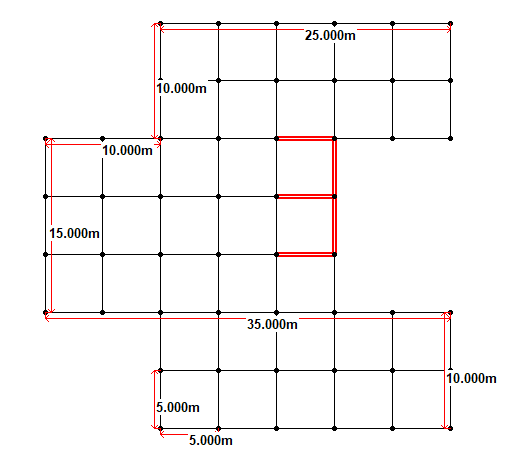
Fig. 1: Typical floor plan
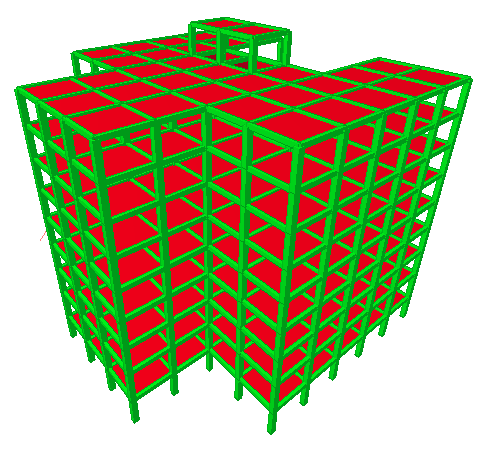
Fig. 2: 3D view of all cases
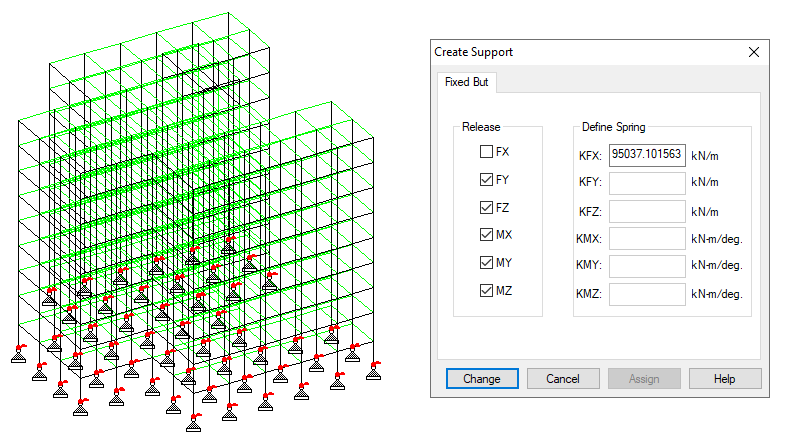
Fig. 3: Case ESP1
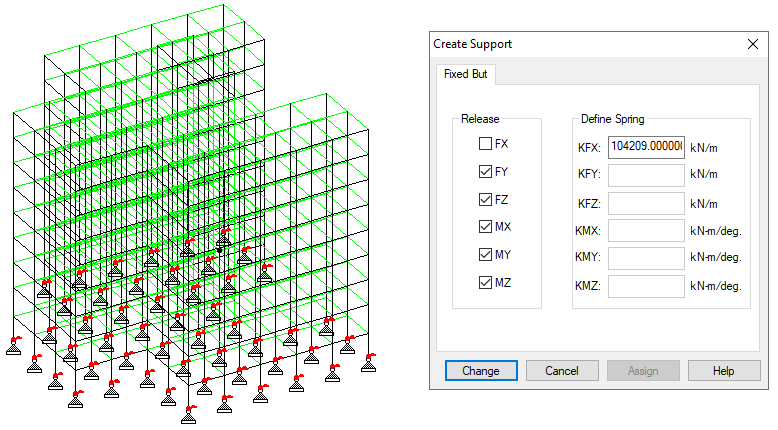
Fig. 4: Case ESP2
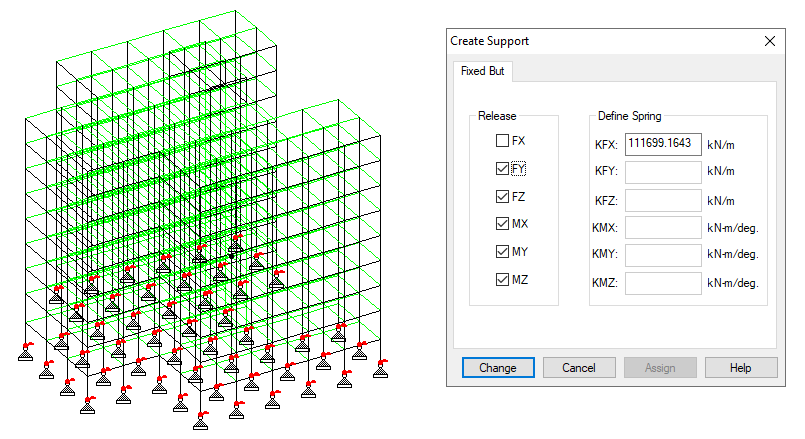
Fig. 5: Case ESP3
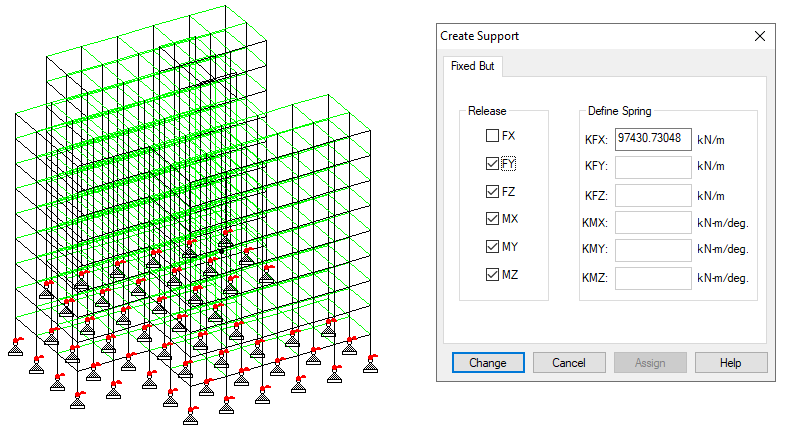
Fig. 6: Case ESP4
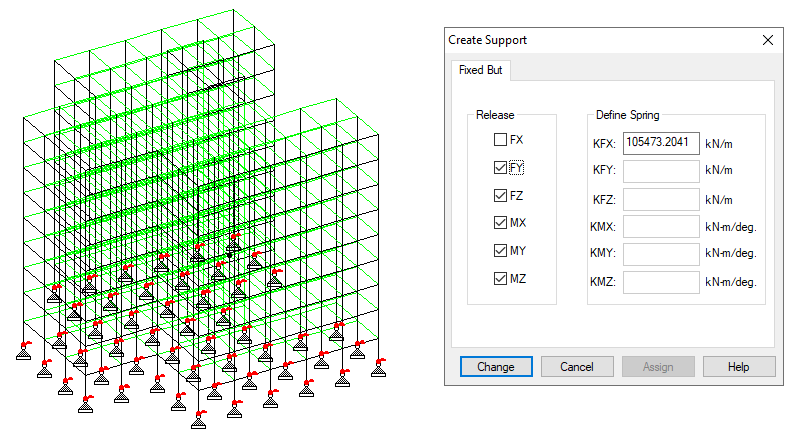
Fig. 7: Case ESP5
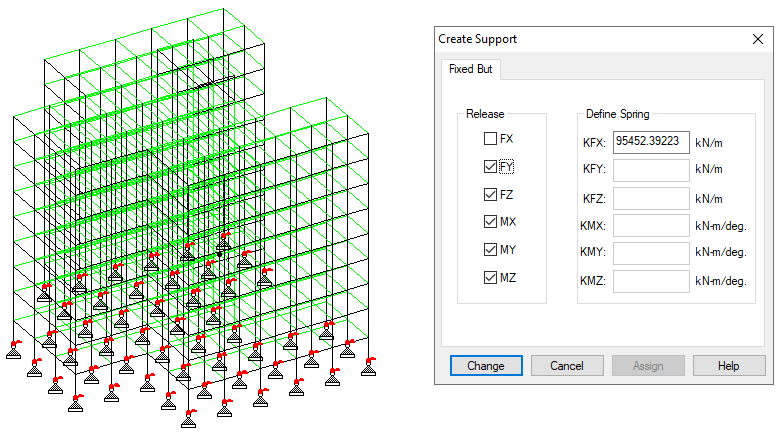
Fig. 8: Case ESP6
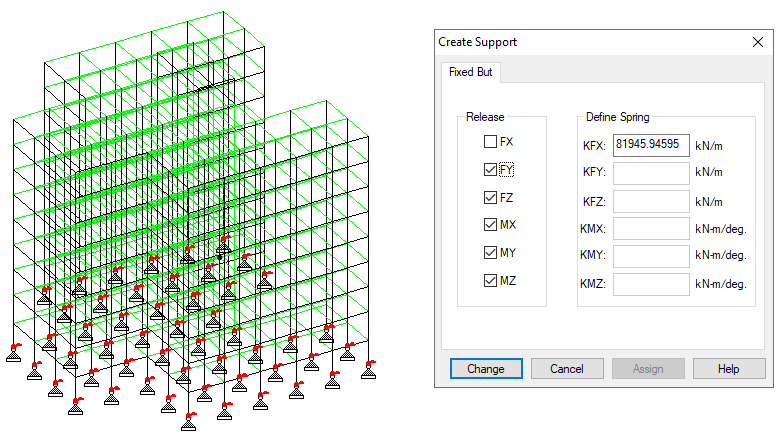
Fig. 9: Case ESP7
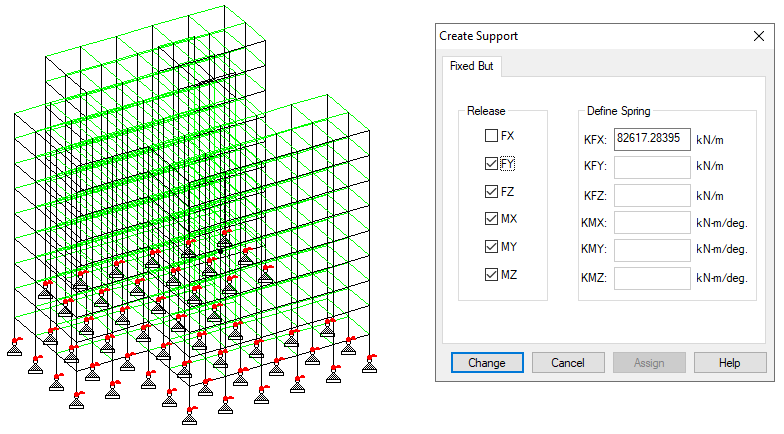
Fig. 10: Case ESP8
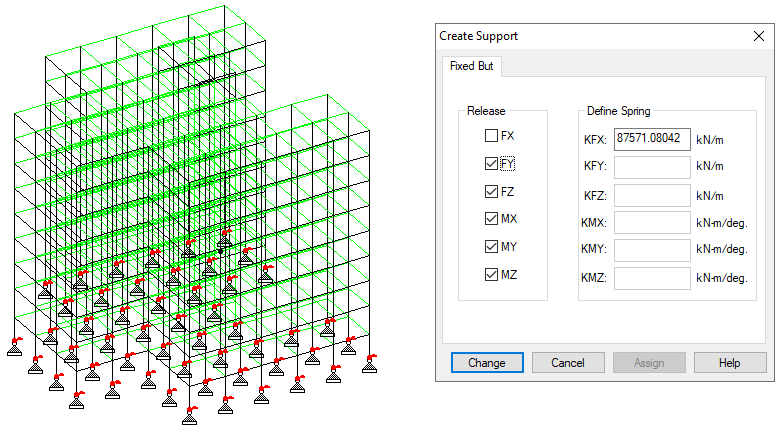
Fig. 11: Case ESP9
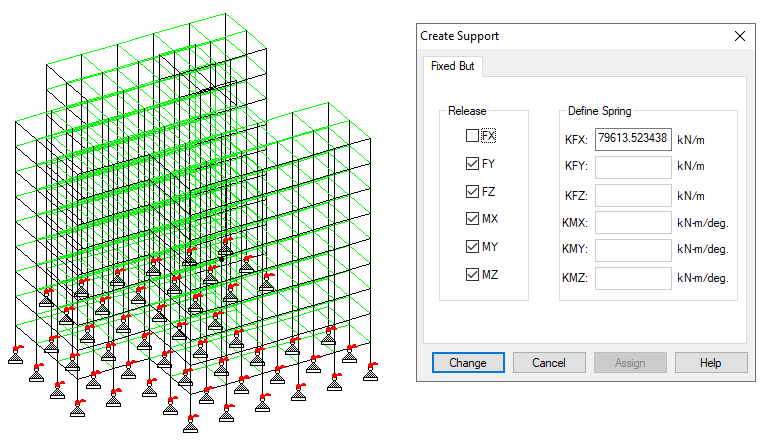
Fig. 12: Case ESP10
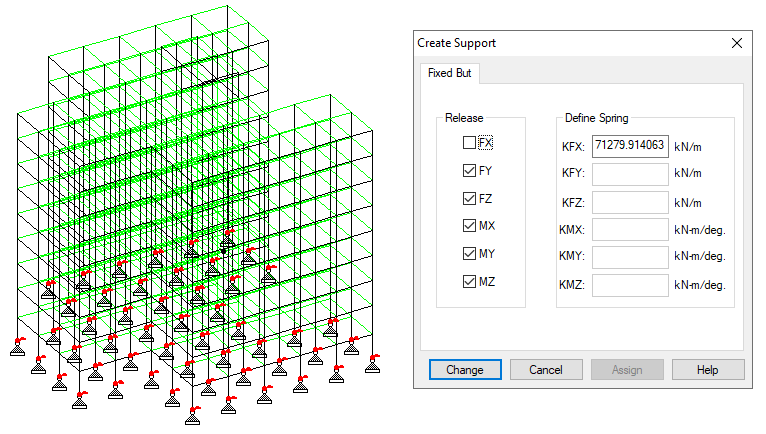
Fig. 13: Case ESP11
IV. RESULTS AND DISCUSSION
As per the objectives, various bore holes of different soil area were analysed and the soil parameters are taken for further study. In this research, models of commercial structure situated at Zone III. For determination of performance and stability of the structure under different soil parameters the following results were obtained:-
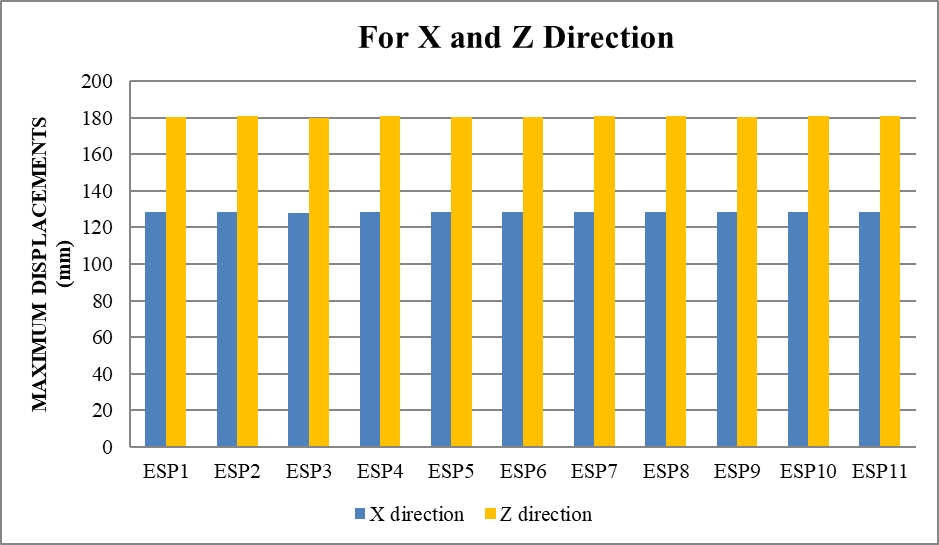
Fig. 14: Graphical Representation of Maximum Displacement in X and Z direction for all Bore holes parameters
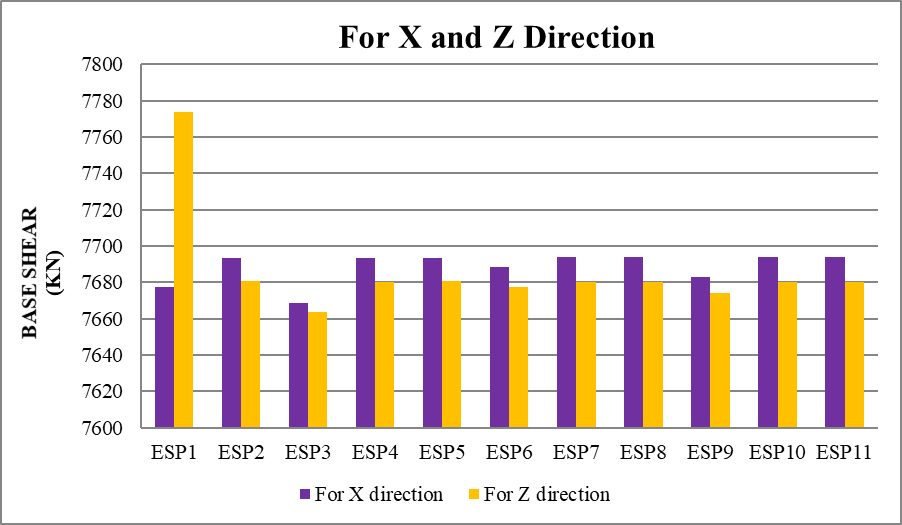
Fig. 15: Graphical Representation of Base Shear in X and Z direction for all Bore holes parameters
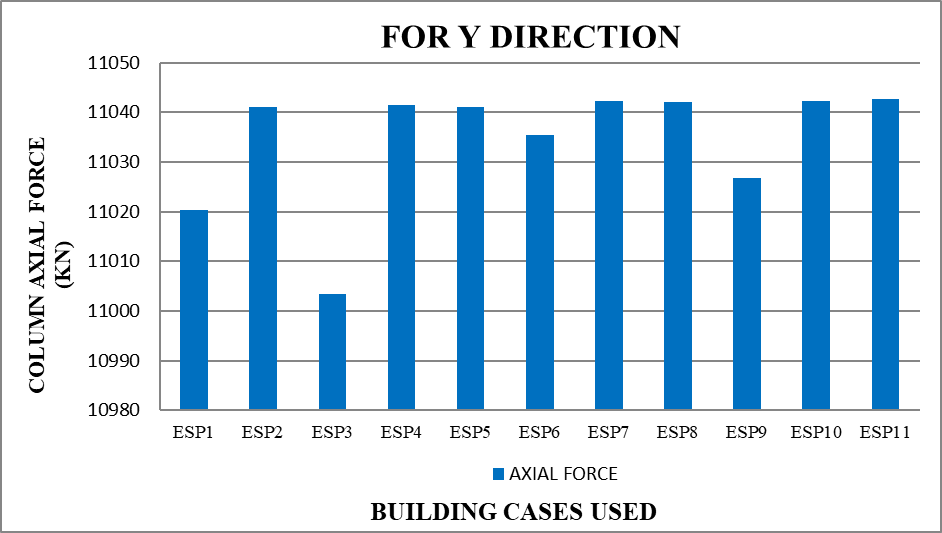
Fig. 16: Graphical Representation of Maximum Axial Forces in Column for all Bore holes parameters
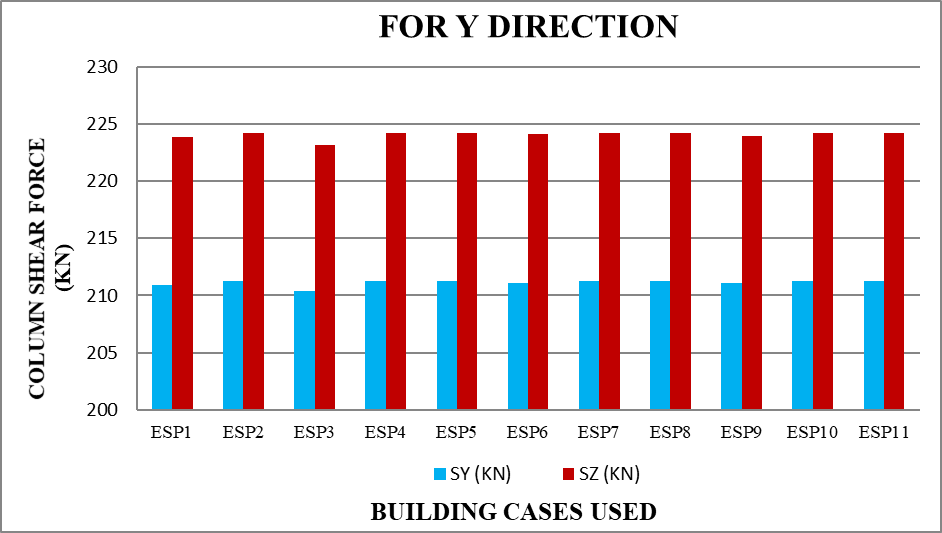
Fig. 17: Graphical Representation of Maximum Shear Force in Column in Column for all Bore holes parameters
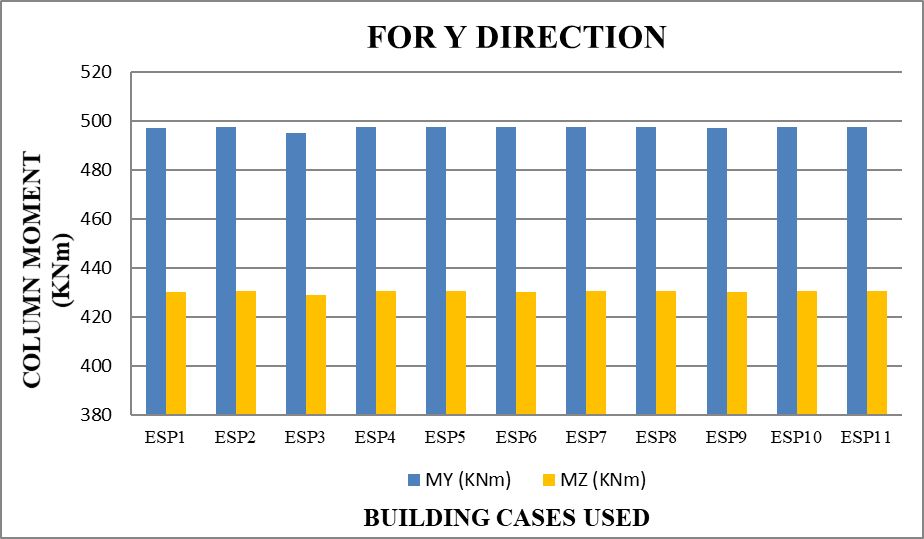
Fig. 18: Graphical Representation of Maximum Bending Moment in Column for all Bore holes parameters
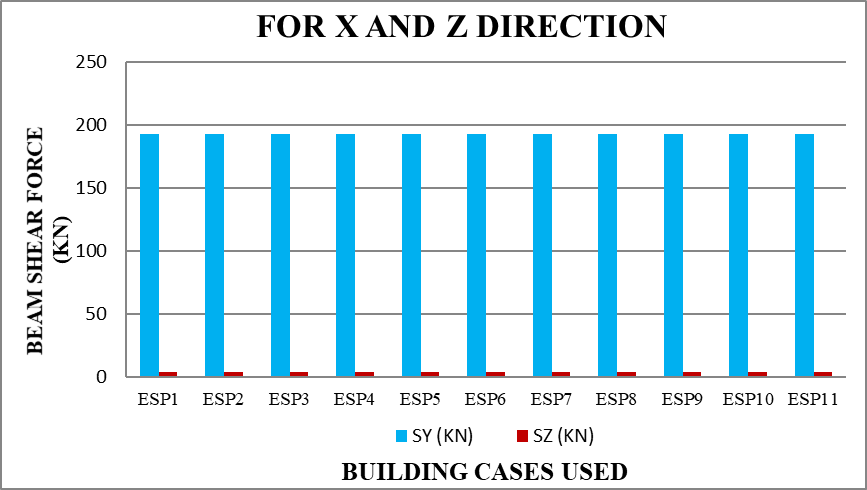
Fig. 19: Graphical Representation of Maximum Shear Force in Beam for all Bore holes parameters
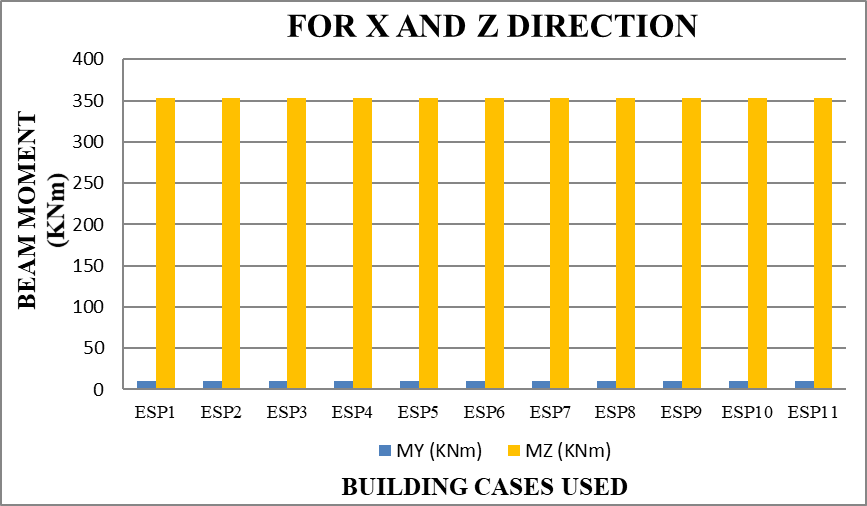
Fig. 20: Graphical Representation of Maximum Bending moment in Beam for all Bore holes parameters
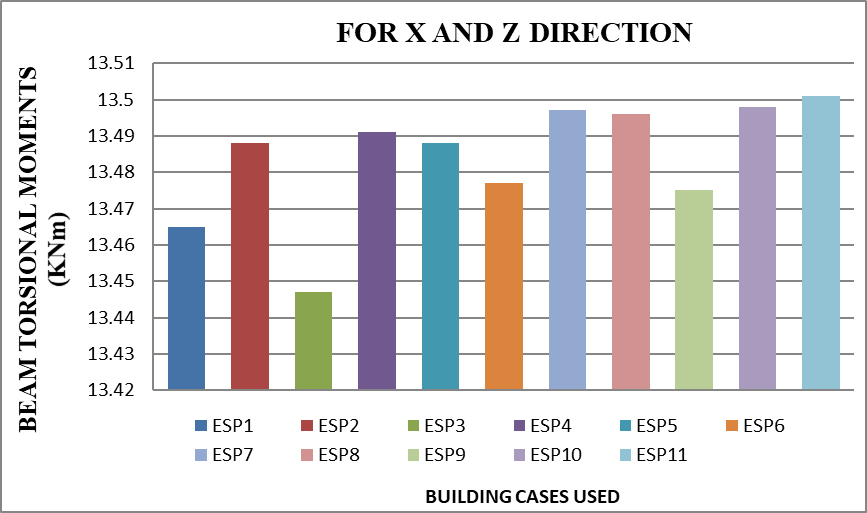
Fig. 21: Graphical Representation of Maximum Torsional Moments in Beams for all Bore holes parameters
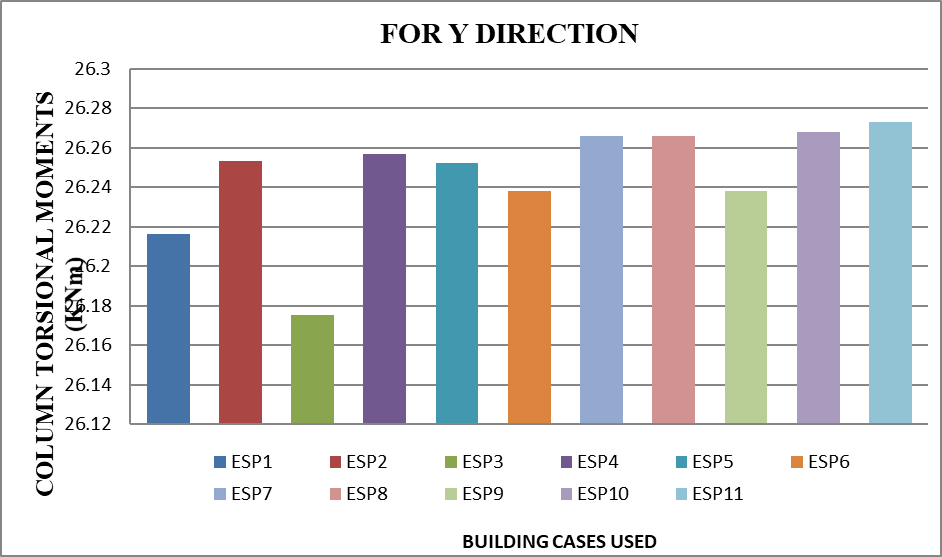
Fig. 22: Graphical Representation of Maximum Torsional Moments in Columns for all Bore holes parameters
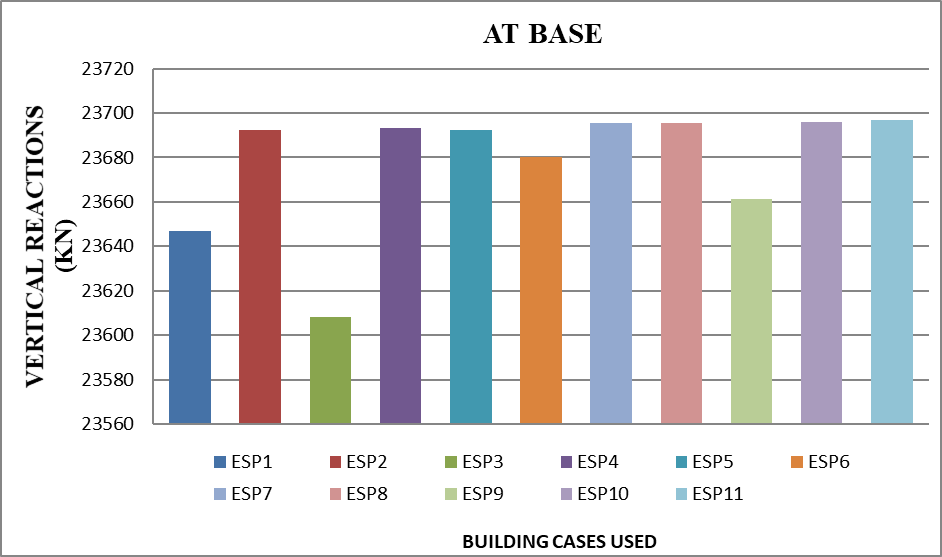
Fig. 23: Graphical Representation of Maximum Vertical Reaction at base for all Bore holes parameters
Conclusion
On the basis of above parameters, following results are obtained from this comparative study:- 1) The minimum values for the analysis of the maximum nodal displacement case are observed in Model Case ESP3, with the lowest values being 128.108 mm and 179.953 mm in the X and Z directions, respectively, when comparing different bore holes. 2) When comparing base shear values, the least values in the X and Z directions for the structure are observed in Model Case ESP3across different bore holes. 3) The examination of Column Axial Forces has shown the least values in Model Case ESP3, with a value of 11003.474 kN, when comparing different bore holes. 4) The Shear Force values in the column have been found to be minimum in Model Case ESP3, proving it to be the most efficient case for different bore holes. 5) The examination of Bending Moment values in the column has been conducted, with minimum values found in Model Case ESP3 when compared across different bore holes. 6) The Shear Force values in the beam are found to be efficient in Model Case ESP3. 7) Upon examining the Bending Moment values for the beam, Model Case ESP3 is found to be the most efficient case, with minimum values in comparison. 8) The determination and comparison of member Torsion values in beam members have been conducted, with Model Case ESP3 again showing the lowest values. 9) The member Torsion values in column members across different bore holes are found to be lower in Model Case ESP3. 10) The Vertical Reaction at Base values in the beam are observed to be efficient in Model Case ESP3. After obtaining all the values of different parameters from different model cases by using the soil parameters, the research concluded by comparing the maximum load obtained at base, i.e. foundation of the building.
References
[1] Namdar, A., & Feng, X. (2014). Evaluation of safe bearing capacity of soil foundation by using numerical analysis method. Frattura Ed Integrità Strutturale, 8(30), 138–144. [2] Przewlocki, J., & Zielinska, M. (2016). Analysis of the Behavior of Foundations of Historical Buildings. Procedia Engineering, 161, 362–367. [3] Lanko, A., & Ulybin, A. (2016). Express Methods for Determining the Foundation Depths. Procedia Engineering, 165, 1710–1716. [4] Ajdukiewicz, A., Brol, J., Kotala, B., & W?glorz, M. (2017). Some Aspects of Structural Design of Massive Foundations for New Power Plant Buildings. Procedia Engineering, 193, 321–328. [5] Vilas, & Moniuddin, M. K. (2015). Finite Element Analysis of Soil Bearing Capacity using Plaxis. International Journal of Engineering Research & Technology (IJERT), 861. [6] Gupta, S., & Mital, A. (2019). Numerical analysis of bearing capacity of rectangular footing. Journal of Physics. Conference Series, 1240(1), 012039. [7] Fahmi, K. S., Fattah, M. Y., & Pustovgar, A. (2018). Design and Improvement of foundation soil for high-rise construction. MATEC Web of Conferences, 170, 03001. [8] Poulos, H. G. (2016). Tall building foundations: design methods and applications. Innov. Infrastruct. Solut., 1, 10. [9] Dixit, M. S., & Patil, K. A. (2010). Study of Effect of Different Parameters on Bearing Capacity of Soil. In Conference Paper. [10] Archit Dangi, Jamle S., (2018), \"Determination of Seismic parameters of R.C.C. Building Using Shear Core Outrigger, Wall Belt and Truss Belt Systems\". International Journal of Advanced Engineering Research and Science(ISSN : 2349-6495(P) | 2456-1908(O)),vol. 5, no. 9, pp.305-309 AI Publications, doi:10.22161/ijaers.5.9.36 [11] Mohd. Arif Lahori, Jamle S., (2018), \"Investigation of Seismic Parameters of R.C. Building on Sloping Ground\", International Journal of Advanced Engineering Research and Science, (ISSN: 2349-6495(P), 2456-1908(O)), vol. 5, no. 8, pp.285-290 AI Publications, doi: 10.22161/ijaers 5.8.35. [12] Suyash Malviya, Jamle S., (2019), “Response of Multistorey Building with Rooftop Telecommunication Tower in Different Positions: An Approach to Efficient Case\", International Research Journal of Engineering and Technology, (ISSN: 2395-0072(P), 2395-0056(O)), vol. 6, no. 4, pp. 3783-3790. [13] Yash Joshi, Jamle S., (2019), \"Effect of Curtailed Shear Wall on Dynamic Analysis of RC Building\", International Journal of Management, Technology And Engineering, (ISSN: 2249-7455(O)), vol. 9, no. 7, pp. 223-230. [14] Rajesh Chouhan, Jamle S., (2019), “Dynamic Analysis of Tuned Mass Damper on Steel Structure: A Technical Approach\", International Journal of Research and Analytical Reviews, (ISSN: 2348-1269 (O), 2349-5138 (P)), vol. 6, no. 2, pp. 956-960. [15] Neeraj Patel, Jamle S., (2019), “Use of Shear Wall Belt at Optimum Height to Increase Lateral Load Handling Capacity in Multistory Building: A Review”, International Journal of Advanced Engineering Research and Science(ISSN : 2349-6495(P) | 2456-1908(O)),vol. 6, no. 4, pp. 310-314, AI Publications, doi:10.22161/ijaers.6.4.36 [16] Taha A. Ansari, Jamle S., (2019), “Performance Based Seismic Analysis of Regular R.C. Building”, International Journal of Management, Technology And Engineering, ISSN: 2249-7455, Vol. 09, no. 07, pp. 342-351, DOI:16.10089.IJMTE.2019.V9I7.19.28639. [17] Baker, W. F., Brown, C., Pawlikowski, J. J., & Rankin, D. S. (2013). Tall Buildings and Their Foundations: Three Examples. International Conference on Case Histories in Geotechnical Engineering. [18] Du, P., Liu, X., & Zhang, Y. (2017). Discussion of the Method to Determine the Ultimate Bearing Capacity of Soil Foundation. IOP Conference Series. Earth and Environmental Science, 100, 012007. [19] Sagar Jamle, Verma, M. P., Dhakad V., (2017), “Flat Slab Shear Wall Interaction for Multistoried Building under Seismic Forces”, International Journal of Software & Hardware Research in Engineering (IJSHRE), ISSN: 2347-4890, Vol.-05, Issue-3, pp. 14-31. [20] Magar, J., Kudtarkar, A., Pachpohe, J., & Nagargoje, P. (2020). Study and Analysis of Types of Foundation and Design Construction. International Research Journal of Engineering and Technology (IRJET), 3301. [21] Fahmi, K. S., Fattah, M. Y., & Pustovgar, A. (2018). Design and Improvement of foundation soil for high-rise construction. MATEC Web of Conferences, 170, 03001. [22] Gupta, S., & Mital, A. (2019). Numerical analysis of bearing capacity of rectangular footing. Journal of Physics. Conference Series, 1240(1), 012039. [23] Arya, A., & Ameta, D. N. (2017). Bearing Capacity Of Foundation-Review Paper. American Journal of Engineering Research (AJER). [24] Sagar Jamle, Verma, M. P., Dhakad V., (2017), “Flat Slab Shear Wall Interaction for Multistoried Building Analysis When Structure Length is greater than width under seismic Forces”, International Journal of Software & Hardware Research in Engineering (IJSHRE) ISSN: 2347-4890 Vol.-05, Issue-3, pp. 32-53. [25] Xia, H., Zhang, J., Cai, J., Pan, H., & She, X. (2020). Study on the Bearing Capacity and Engineering Performance of Aeolian Sand. Advances in Materials Science and Engineering, 2020, 1–11. [26] CURRENT PRACTICE ON FOUNDATION DESIGN OF HIGH-RISE BUILDINGS IN BANGKOK, THAILAND. (2012). In LOWLAND TECHNOLOGY INTERNATIONAL (Vols. 14–14, Issue 2, pp. 70–83). [27] Zhu, F., Zhang, W., Dong, W., & Sun, M. (2017). A new calculation method for the bearing capacity of soft soil foundation. Advances in Mechanical Engineering/Advances in Mechanical Engineering, 9(10), 168781401773252. [28] Surendra Chaurasiya, Jamle S., (2019), “Twin Tower High Rise Building Subjected To Seismic Loading: A Review\". International Journal of Advanced Engineering Research and Science (ISSN : 2349-6495(P) | 2456-1908(O)), vol. 6, no. 4, pp. 324-328, AI Publications, doi:10.22161/ijaers.6.4.38. [29] Archit Dangi, Jamle S., (2019), Stability Enhancement of Optimum Outriggers and Belt Truss Structural System\", International Research Journal of Engineering and Technology, (ISSN: 2395-0072(P), 2395-0056(O)), vol. 6, no. 2, pp. 772-780. [30] Mohd. Arif Lahori, Jamle S., (2019), \"Response of Multistory Building Located on 200 and 300 Sloping Ground under Seismic Loading\", International Research Journal of Engineering and Technology, (ISSN: 2395-0072(P), 2395-0056(O)), vol. 6, no. 1, pp. 1063-1069. [31] Determination Of Bearing Capacity Of Gravel Boulder Deposit From Footing Load Test. (2012). In Proceedings of Indian Geotechnical Conference.
Copyright
Copyright © 2024 Ritik Patil, Afzal Khan. This is an open access article distributed under the Creative Commons Attribution License, which permits unrestricted use, distribution, and reproduction in any medium, provided the original work is properly cited.

Download Paper
Paper Id : IJRASET66054
Publish Date : 2024-12-22
ISSN : 2321-9653
Publisher Name : IJRASET
DOI Link : Click Here
 Submit Paper Online
Submit Paper Online

